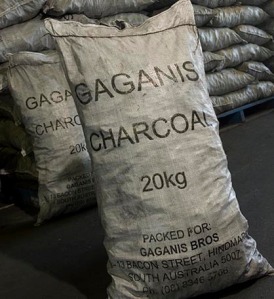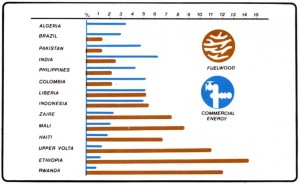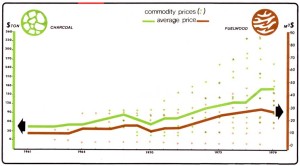 An undated study by the UN’s Food and Agriculture Organization that sought to discover the real cost of woodfuel concluded that, ultimately, it’s impossible to know. And rightly so. How do you factor in time spent collecting the wood? The loss of the resource? Decline in value of ecosystem services? Cost of future replacement of extinguished resource with alternative fuel?
An undated study by the UN’s Food and Agriculture Organization that sought to discover the real cost of woodfuel concluded that, ultimately, it’s impossible to know. And rightly so. How do you factor in time spent collecting the wood? The loss of the resource? Decline in value of ecosystem services? Cost of future replacement of extinguished resource with alternative fuel?
The authors point out that it’s not a futile excercise altogether. Valuing woodfuel is actually vital to those responsible for managing energy resources because,
“…it may provide invaluable warning signals of developing scarcities in a manner that is understandable both to the community and to the authorities responsible for energy supply. Galloping inflation of fuelwood prices is in itself a warning about forest destruction and depletion of future fuelwood supplies. It is, of course, a painful way to learn, especially for the poorest members of the community. It is preferable that the economic value of trees and forests as sources of energy be adequately appraised and that action be taken to conserve and extend forestry and tree-growing wherever ecologically feasible and economically sensible.” (my emphasis)
Nothing terribly surprising in this conclusion.
However, I raise this issue because it seems that all the public discussion is presently focused on preserving standing forests in developing countries in the context of climate change (REDD), and not the benefits to poverty, environmental, or public health alleviation. Yes, I understand REDD is the mechanism that will pay for forest protection and restoration, but how much stronger would the argument be if we could provide a $ figure reflecting the importance of forested areas beyond the context of REDD? [A plug here for the excellent work done in the ecosystem services/valuing nature arena by the folks over at the Natural Capital Project] Wouldn’t it make it easier for industrialized nations to sell the notion of forest carbon offsets if it could also point to the value of additional services being provided by forest protection and restoration?
Funding a global campaign to replace three-stones-and-a-pot with energy-efficient stoves and briquettes would also be a lot easier if we could value the forest for all the services it provides.
And for the hardcore energy economist out there, I’ve taken the liberty of copying some excellent graphs from the study and pasting them below.
 Figure 1. This graph shows a sample of 14 developing countries in which the consumption of commercial energy mainly oil and coal – ranges from 1 to 6 percent of the gross domestic product (GDP). The value of fuelwood and charcoal consumption is calculated at from 1 to 15 percent of GDP. In three low-income countries, Upper Volta, Ethiopia and Rwanda, fuelwood accounts for more than 10 percent of GDP. In these countries, and in Mali and Haiti where fuelwood makes up 7 and 8 percent of GDP, the supply of fuelwood is already very scarce. Although we are comparing fossil fuels and fuelwood, the people who “pay” for this energy are not paying in petrodollars. Indeed, to a great extent they do not pay in cash at all, but with their own labour and time. Still, they pay, and they may have to pay a much higher price for their energy if the fuelwood supply is allowed to become exhausted. At that point they will be forced to resort to costly alternative fuels.
Figure 1. This graph shows a sample of 14 developing countries in which the consumption of commercial energy mainly oil and coal – ranges from 1 to 6 percent of the gross domestic product (GDP). The value of fuelwood and charcoal consumption is calculated at from 1 to 15 percent of GDP. In three low-income countries, Upper Volta, Ethiopia and Rwanda, fuelwood accounts for more than 10 percent of GDP. In these countries, and in Mali and Haiti where fuelwood makes up 7 and 8 percent of GDP, the supply of fuelwood is already very scarce. Although we are comparing fossil fuels and fuelwood, the people who “pay” for this energy are not paying in petrodollars. Indeed, to a great extent they do not pay in cash at all, but with their own labour and time. Still, they pay, and they may have to pay a much higher price for their energy if the fuelwood supply is allowed to become exhausted. At that point they will be forced to resort to costly alternative fuels.
Figure 2. The price of fuelwood is an important factor to people who do not collect it “free” but have to buy it at the market. This price is also important to producers and growers who must decide on investments in harvesting, transport and replanting of the trees. Governments know that fuelwood prices can be a sensitive matter and are a regular feature of consumer price statistics in several countries where wood is a major urban fuel.
And for the geek statistician in all of us:
EQUIVALENT ENERGY VALUES OF SOME COMMON FUELS
| FUEL | UNIT | COAL EQUIVALENT (MT) |
OIL EQUIVALENT (BARRELS) |
ENERGY CONTENT (GIGAJOULES) |
| FUELWOOD | M3 | 0.33 | 1.6 | 9.4 |
| CHARCOAL | MT | 1.0 | 5.0 | 28.9 |
| CRUDE OIL | BARREL | 0-2 | 1-0 | 5-8 |
ONE GIGAJOULE IS 109 JOULES


